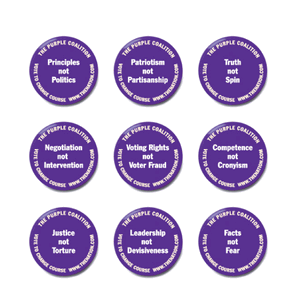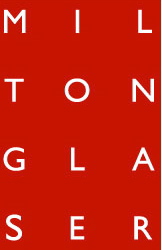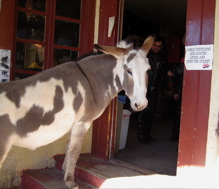Straight Up |: February 2008 Archives
Call it "Pissing Strange." It's not the rock musical "Passing Strange," which just opened on Broadway to crix raves. And it's not with Snooky Lanson, either. Mother Jones magazine calls it "The Torture Playlist" -- a k a the top songs used on detainees in American military prisons "to induce sleep deprivation," to "prolong capture shock," and to "drown out screams."
The day after CNN reported that "Nader takes steps towards another White House bid," I had an exchange -- it was a month ago -- with Henry Kisor, an old friend from former years at the Chicago Sun-Times. Citing that report, I said in a comment on one of Henry's blogposts, None of the above, "Go, Ralph, Go!"
 The 79-year-old graphic designer perhaps most famous for creating the I♥NY logo had a dose of surprising advice last week for the propagandists among us -- the marketers, advertisers, public-relations spinners and, yes, journalists -- along with citizens at large facing an onslaught of political campaigns.
The 79-year-old graphic designer perhaps most famous for creating the I♥NY logo had a dose of surprising advice last week for the propagandists among us -- the marketers, advertisers, public-relations spinners and, yes, journalists -- along with citizens at large facing an onslaught of political campaigns.
It is "essential for us all to question all the beliefs we cherish," Milton Glaser said in his keynote speech to a daylong 'ganda bash, "Where the Truth Lies," organized by the School of Visual Arts with The Graduate Center, CUNY. "Beliefs must be held lightly because certainty can be the enemy of truth."
Propaganda "substitutes an alien authority for our own perception," he said, adding that "the intersection of fear and persuasion has created the world as we know it" and that we are faced with a "constant and relentless subversion of what is real."
![Milton Glaser, info maestro [Photo: JH]](http://www.artsjournal.com/herman/glaser181.jpg) Art is the antidote, Glaser asserted. "Art may be the only truth we can ever know," he said. Through art, "what is real becomes visible." Thus, he takes as his touchstone the words of the poet Horace: "The purpose of art is to inform and delight." Notice, he said, that "Horace did not say persuade and delight."
Art is the antidote, Glaser asserted. "Art may be the only truth we can ever know," he said. Through art, "what is real becomes visible." Thus, he takes as his touchstone the words of the poet Horace: "The purpose of art is to inform and delight." Notice, he said, that "Horace did not say persuade and delight."
Furthermore, "art is a survival mechanism for the human species," Glaser noted. "Otherwise it would not have lasted this long." He cited the Lascaux cave paintings of prehistoric times to bolster his point.
In addition to the advice that peppered his speech, Glaser showed slides of some of his work. One, displaying a set of buttons created for The Nation magazine, was called "The Purple Coalition" -- as opposed to red or blue -- and it doesn't seem to have worked yet. It offered the following epigrams, one to a button, and a few more:

Principles not politics
Strength not stubbornness
Justice not junkets
Patriotism not ideology
Cooperation not corruption
Truth not spin
Openness not secrecy
Negotiation not intervention
Jobs not pay-offs
Civility not mudslinging
Voting rights not voter fraud
Security not torture
Civil rights not surveillance
Competence not cronyism
Leadership not devisiveness
Facts not fear
Another slide, titled "Goodbye," displayed four buttons with two characters each -- IM PE AC H! -- and a caption that said: "Help send the president on his way with this new four-button set." Sadly, given the results so far, that too is one of Glaser's less persuasive -- or to use his term, informative -- designs.
In "The War That Isn't," his latest column in National Journal, William Powers notes, "It's not at all unusual lately to pick up a large metropolitan newspaper and find that there is nothing -- zero -- on the front page about a war in which nearly 4,000 Americans have died." (Let alone the tens of thousands wounded. Or the hundreds of thousands of dead or wounded Iraqis and the millions forced to flee.)
Not to worry. Unless you agree with George C. Wilson, whose article in Army Times and other military publications, "Vietnam Redux," points out, "Now, as then, [the] generals are leading us down the primrose path." But this kind of news, as Powers says, "gets lost in the noise of other news." You know: "Obama and the Clintons. The mortgage crisis. Sports. The Hollywood writers' strike. The Clintons. The weather. Obama. Celebrities in trouble. Obama. Your health."
Postscript: An inherent part of genocide is to deny that people have died. Read "Counting Iraqi Casualties -- and a Media Controversy," about "the war's exceptional human costs" and the smear campaign to deny them. It is a devastating indictment of the American press -- and National Journal and The Wall Street Journal in particular -- by John Tirman, the executive director and a principle research scientist at M.I.T.'s Center for International Studies. Tirman commissioned the survey published in the British medical journal, the Lancet, in October 2006, that concluded that 600,000 Iraqis died during the first 40 months of the war.
Big all-day propaganda conference coming up in midtown Madhattan: "Where the Truth Lies." Keynoter: Milton Glaser. He asks, per the press release, "Is there any difference between good propaganda and bad propaganda?" Put another way, "Where does truth end and 'spin' begin?"
 Topics include: How American Presidents Persuade the Public to Go to War. "It is not war that Americans hate, but, rather, unsuccessful wars," says Eugene Secunda, a marketing and media prof at NYU, per the release. He explains why a majority of Americans "are more than willing to buy a war if it is properly packaged and skillfully marketed."
Topics include: How American Presidents Persuade the Public to Go to War. "It is not war that Americans hate, but, rather, unsuccessful wars," says Eugene Secunda, a marketing and media prof at NYU, per the release. He explains why a majority of Americans "are more than willing to buy a war if it is properly packaged and skillfully marketed."
How about this one? Learning from Las Vegas. "Progressives continue to depend upon sober reason to guide them," says Stephen Duncombe, a political activist and NYU prof. He believes they need to adopt a "spectacular vernacular" without adopting Vegas values. (Paul Krassner, anyone?) And this: The Changing Face of Consumer Marketing. "Sam Travis Ewen -- the man behind the LED light boards that prompted officials to shut down Boston last year -- has some answers." (Abbie Hoffman, anyone?)
Whenever I read or hear about the success of the surge, I substitute the phrase bribes to the tribes. Those four little words make a world of difference, and they go back a long way -- viz. "Protection Payments" made to Tribes in Ottoman Gaza (1519-1582) -- but you don't see them often enough in news accounts of the Iraq war.
Nor do you hear the President With His Head Up His Ass boasting about our bribes to the tribes. He brags instead, as he did the other day, about "the surge of forces." Even a lengthy report that broke the news of the new Army operations manual on counterinsurgency, revised after the "hard-won lessons" of Afghanistan and Iraq, fails to mention bribery. It speaks instead about the importance of street patrols.
![From Joshua Brown's 'Life During Wartime' [Jan. 23, 2008] Click to enlarge.](http://www.artsjournal.com/herman/From%20Joshua%20Brown%27s%20%27Life%20During%20Wartime%27%20%28260%29.jpg) Maybe when the revised operations manual is made public later this month, we'll see the inclusion of a new doctrinal tactic to formalize what has already happened: "Bring lotsa cash to buy off the enemy, especially in ten-million-dollar bricks."
Maybe when the revised operations manual is made public later this month, we'll see the inclusion of a new doctrinal tactic to formalize what has already happened: "Bring lotsa cash to buy off the enemy, especially in ten-million-dollar bricks."
(Hmmm, thanks to Fred Kaplan at Slate, I see that the manual has already been posted in a huge pdf file by Secrecy News. Downloading the 314-page manual-- it's 28 MB -- is guaranteed to freeze your browser for a while. But I managed, and a quick glance through the pages indicates that bribing insurgents is not mentioned anywhere.)
A weapons analyst I know can't understand why "the press lays off all this stuff. It scrubs everything clean, sanitizes it, and presents it in the best possible light. If this were a Democratic president overseeing strategy, he would be ripped apart. We have a real scandal. It's not Whitewater. It's something at the highest level of national security."
In fairness, I have to point out that it's not as if bribes to the tribes have gone unnoticed. Not too long ago, the BBC reported, as did others, that the payoffs have made al-Qaeda's Ayman al-Zawahiri very unhappy. (Scroll way down.) And they were mentioned in passing only yesterday by NYT reporter Alissa J. Rubin. She noted that groups paid by the American military "to fight Islamic extremists" in Iraq's Anbar Province "have mostly seemed to be cooperating," although recently "their behavior has been [um] problematic."
Meaning, of course, that bribes notwithstanding they'd rather put their own interests ahead of ours and others'. Now ain't that a surprise.
 Just back from a trip to Arizona, where I met a herd of typical McCain voters wandering through the business district of Oatman, a former mining town that evokes the Old West with the aura if not quite the flair of a Wile E. Coyote cartoon. This voter was about to enter the polling booth at a local hotel. (In case you're wondering, the sign says, "Public restrooms are across and down the street.⇒") And here's a closeup of the leaders of the herd:
Just back from a trip to Arizona, where I met a herd of typical McCain voters wandering through the business district of Oatman, a former mining town that evokes the Old West with the aura if not quite the flair of a Wile E. Coyote cartoon. This voter was about to enter the polling booth at a local hotel. (In case you're wondering, the sign says, "Public restrooms are across and down the street.⇒") And here's a closeup of the leaders of the herd:
Sites to See
AJ Blogs
AJBlogCentral | rssspecial
the blog of the National Performing Arts Convention
Terry Teachout on the arts in New York City
Andrew Taylor on the business of arts & culture
rock culture approximately
Rebuilding Gulf Culture after Katrina
Douglas McLennan's blog
Art from the American Outback
John Rockwell on the arts
Jan Herman - arts, media & culture with 'tude
dance
Apollinaire Scherr talks about dance
Tobi Tobias on dance et al...
media
Jeff Weinstein's Cultural Mixology
Martha Bayles on Film...
music
Greg Sandow performs a book-in-progress
Howard Mandel's freelance Urban Improvisation
Focus on New Orleans. Jazz and Other Sounds
Exploring Orchestras w/ Henry Fogel
Kyle Gann on music after the fact
Doug Ramsey on Jazz and other matters...
Greg Sandow on the future of Classical Music
Norman Lebrecht on Shifting Sound Worlds
publishing
Jerome Weeks on Books
Scott McLemee on books, ideas & trash-culture ephemera
theatre
Chloe Veltman on how culture will save the world
Elizabeth Zimmer on time-based art forms
visual
Public Art, Public Space
John Perreault's art diary
Lee Rosenbaum's Cultural Commentary
Tyler Green's modern & contemporary art blog
